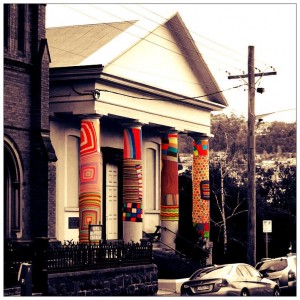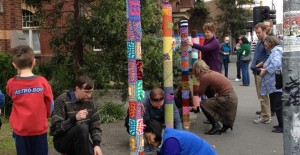Many church buildings like the stone hall at City Baptist Church in Launceston have a grandeur and aloofness that can make them difficult to penetrate for an outsider. One solution to counteract that view: adorn them in cozy yarn, knitted and crocheted by loving hands.

City Baptist Church in Launceston was yarn-bombed (with permission) as part of the Junction Arts Festival this month.
Photo credit: Mark Barry
The yarn-bombing trend, sometimes also called ‘guerilla knitting’, ‘grandma graffiti’ or ‘yarn storming’, is the art of crochet and knitted graffiti thus creating non-permanent art installations. The New York Times has called it “graffiti’s cozy, feminine side”, a “global phenomenon” that has spread across world since one of the first recorded yarn bomb examples occurred in Texas in 2005, as knitters found a creative way to use leftover or unfinished knitting and crochet projects to wrap around signposts, street poles and other inanimate public objects.
It’s a craze the City of Melbourne has particularly embraced in recent years, although it is now spreading to other parts of Australia. In Launceston, the creative display outside City Baptist Church was created as part of the Junction Arts Festival, with permission from the church. But regardless of the identity of the ‘stitchers’, the activity has put the church on the map.
Further up the eastern seaboard in Port Stephens on the central coast of New South Wales, a craft group from St Francis’ Anglican Church made a more concerted effort to use the new craze to draw attention to their church.
“I dreamt it up, I guess,” St Francis’ yarn-bombing organiser Wendy Sneddon told Eternity. “Our church is tucked away around a corner. You’d ask someone where it is, and they couldn’t tell you. We wanted to try and raise our profile in the community.”
A contemporary church building to house the congregation has superseded the old church hall at St Francis. But the old hall, described by Wendy as a “pretty ugly, garage-type building” still exists and was in need of some work. And what better way to hide an ugly façade than 120 knitted squares of ten inches stitched together to make a giant blanket?
Wendy spearheaded a group of several church members from the existing craft group, drawing up patterns and laying out the plan on a grid, then dividing up the knitting work.

Wendy Sneddon displaying the giant blanket outside St Francis’s church hall in Medowie, Port Stephens. Photo Credit: St Francis Anglican Church
“People took whatever they could handle,” said Wendy, with the more experienced hands taking the “fiddly” bits. The church’s craft group met fortnightly in the lead up to the unveiling of their yarn-bomb project, eventually bringing their works together and stitching it into the one installation, laid out over Wendy’s living room floor.
“Some of the men in our church got involved to help us work out how to attach the giant blanket to the external wall of the church,” she said.
Wendy says the event “worked brilliantly” in drawing attention to the church. They had articles in their local newspaper, interviews on radio, and visitors arrived from the other side of town to take a look at the crafty work.
On top of all that, the giant blanket was eventually taken down and divided up as smaller blankets to donate to the Samaritans winter appeal.
In Victoria last year, the Brunswick Baptist Church ‘Yarn over Yarn’ group yarn-bombed the posts outside their church.
“Over the last few months a group from church and the community have gotten together to learn the resurgent art of crochet and knitting. Our project has been to completely cover yellow poles out the front of church – very UGLY yellow poles – and now it is done,” Trudy van Meggelen the group organiser told the Baptist Union Victoria in an interview last year.

Outside Brunswick Baptist Church on Sydney Road in Melbourne. Photo credit: Baptist Union Victoria.
The church, located on Melbourne’s eclectic Sydney Road has also attracted attention with its knitted antics. Passers-by stop to take photos or play with the ‘interactive’ poles, those poles with knitted pockets housing knitted surprises.
It would seem, from these three church examples that the homely art of knitting and crochet, already part of a revival for hipster-type young’uns, is also weaving its way back into church life as the social activity it used to be.
And now, not only can it be used as an excuse for a yarn over tea with a friend, it may actually be the conduit to make a passerby look up and notice, ‘Oh yeah, there is a church in this area. And doesn’t it look warm and cozy?’
Email This Story
Why not send this to a friend?
